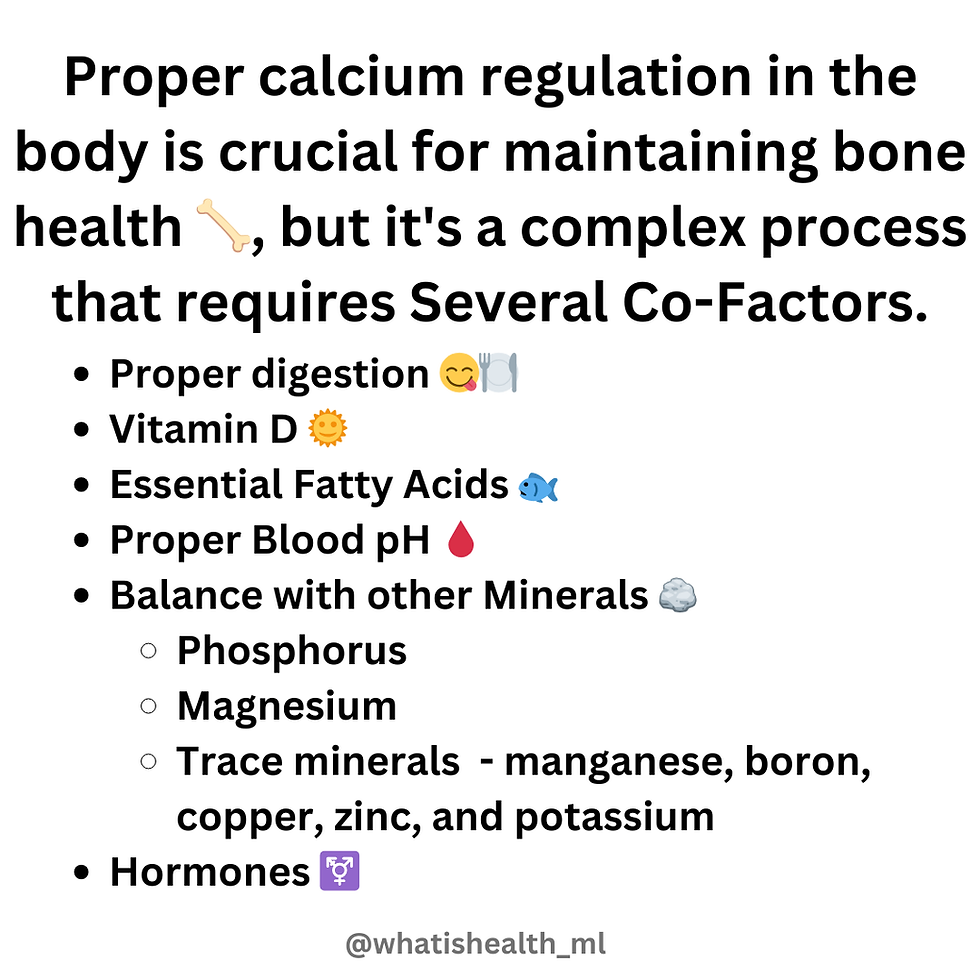The Myth of Milk and Bone Health: Understanding Calcium and Osteoporosis
- Marnie
- Jun 14, 2024
- 6 min read
For many years, we have been led to believe that drinking milk is the key to building strong bones and preventing osteoporosis later in life. This prevailing myth—that drinking milk as children builds up a "calcium bank" to avoid fractures and osteoporosis in adulthood—is simply not true. Bone health is determined by a variety of factors, including diet, stress levels, physical activity, muscle mass, and the balance between bone build-up and breakdown.

The Importance of Bone Health
Osteoporosis, a condition characterized by weak and brittle bones, is a very common and life-threatening problem. Despite its prevalence, it is silent and often under diagnosed, which underscores the importance of prevention. Proper calcium regulation in the body is crucial for maintaining bone health, but it's a complex process that requires several co-factors.
In today’s post, I want to provide information that goes beyond the common advice of taking calcium supplements or drinking milk for bone health. Many people don't realize that simply taking calcium alone is not effective and can even be harmful (I'll address why in another blog post). Read on to learn more about supporting your bone health comprehensively.
Calcium Regulation: The Need for Co-Factors
Calcium regulation in the body is a complex process that requires the involvement of several co-factors to ensure proper digestion, absorption, and utilization of calcium. By incorporating these elements into your daily routine, regardless of your age, you can support your body in making new bone cells and maintaining overall bone health.
Digestion
Calcium and other minerals require an acidic environment for optimal uptake. Hydrochloric acid in the stomach helps to dissolve calcium salts, making calcium more available for absorption in the intestines. Adequate stomach acid levels are crucial for this initial step in calcium digestion.
What You Can Do:
Eat a Balanced Diet: Include foods that naturally stimulate stomach acid production, such as protein rich foods, fermented foods, and citrus fruits as well as bitter foods such as arugula, dandelion greens, and ginger.

Avoid Overuse of Antacids: Overusing antacids or staying on PPI’s for too long can reduce stomach acidity, hindering calcium absorption. This can have long term effects on bones among other health issues related to low stomach acid.
Stay Hydrated: Adequate water intake supports overall digestive health, including stomach acid production. It is best to drink water prior to eating by about 30 minutes as well as after your meal, this will ensure you do not dilute your stomach acid secretion.
Chew Your Food Thoroughly: Properly chewing food can help stimulate digestive enzymes and stomach acid production.
Supplement: Betaine Hydrochloride/HCl (pronounced HCL) can be used to increase stomach acid, and/or Digestive bitters to stimulate the production of stomach acid.
Vitamin D
Vitamin D plays a critical role in calcium absorption from the gut. It increases the efficiency of calcium uptake by promoting the production of calcium-binding proteins in the intestinal lining. Without sufficient vitamin D, the body cannot absorb enough calcium, regardless of dietary intake.
What You Can Do:
Get Sun Exposure: Spend time outdoors in sunlight for about 15-30 minutes several times a week to boost vitamin D levels (without sunscreen).

Eat Vitamin D-Rich Foods: Include foods such as fatty fish (salmon, mackerel) and egg yolks in your diet, Two eggs can provide 82% of the recommended daily intake of vitamin D.
Consider Supplements: If you have low vitamin D levels, (optimal is 30 - 50 ng/ml) consider taking a supplement that has Vitamin K in it as well.
Regular Blood Work: Get your vitamin D levels checked regularly, especially if you are at risk for deficiency. Test Don’t Guess!
Essential Fatty Acids (EFAs)
EFAs are necessary for transporting calcium across cell membranes and into cells. They help increase tissue calcium levels, ensuring that calcium is delivered to where it is needed most, such as bones and teeth.
What You Can Do:
Incorporate Omega-3 Fatty Acids: Eat foods rich in omega-3 fatty acids, such as fish (salmon, sardines), flaxseeds, chia seeds, and walnuts.
Consider Supplements: If your diet is low in EFAs, consider taking fish oil, cod liver oil, or flaxseed oil supplements.
Balance Omega-6 Intake: Reduce consumption of processed foods high in omega-6 fatty acids to maintain a healthy omega-3 to omega-6 ratio. Omega 6 fatty acids are high in seed oils such as Corn oil, Soybean oil, Sunflower oil, Safflower oil, Cottonseed oil, Grapeseed oil, which are used in packaged goods, chips, baked goods, margarines, etc. Best to not cook with these at home and find ways to stay away from them when buying things at the grocery store as much as possible.
Systemic pH
Calcium acts as a major buffer for blood pH, helping to maintain the body's acid-base balance. Changes in blood pH can affect calcium solubility and its deposition in tissues.
What You Can Do:
Eat a Balanced Diet: Emphasize a diet rich in protein, fruits, vegetables, and maintain good stomach acid, as this helps keep the intestines in balance as well.
Stay Hydrated: Drink plenty of water to help maintain proper pH balance, and incorporate electrolytes to help support healthy levels of sodium, potassium, chloride and magnesium.
Balance with Other Macro Minerals
Phosphorus -
Phosphorus acts as the opposing mineral to calcium, making their balance essential for bone health and overall metabolic processes. The ideal dietary ratio is approximately 1:1 to 2:1 (calcium to phosphorus). When this balance is disrupted, it can negatively impact bone density and health. High phosphorus levels can reduce calcium absorption, leading to potential deficiencies and affecting bone health.
It is important to note that while phosphorus is the antagonist to calcium, the body responds differently when phosphorus is in its organic, whole, unrefined form. In this state, phosphorus is naturally buffered with other minerals and vitamins that act as synergistic co-factors to enhance calcium metabolism.
What You Can Do:
Limit Processed Foods: Processed foods often contain high levels of phosphorus. Choose whole foods instead.
Examples of processed foods high in phosphorus additives:

Sodas which contain phosphoric acid for flavor and preservation
Fast foods and frozen meals - Many fast food items and frozen dinners use phosphates to enhance flavor and extend shelf life.
Packaged baked goods - Commercially baked products like cakes, cookies, and muffins often contain phosphates as leavening agents.
Processed snack foods - Chips, crackers, and other snack foods may include phosphorus additives for flavor enhancement and shelf stability.
Read Labels: Be aware of phosphorus additives in foods and choose products with fewer additives.
Look for the following common phosphorus-containing ingredients when looking at labels. Phosphoric Acid and Monosodium Phosphate.
Magnesium
Magnesium is crucial for the proper utilization of calcium. Approximately half of the body’s magnesium is found in soft tissues and muscle cells, while the remainder is in the bones. About one-third of dietary magnesium is absorbed in the small intestine. Magnesium deficiency, common in many diets, can hinder calcium absorption and utilization, leading to improper calcium deposition and potential bone health issues.
What You Can Do:
Include Magnesium-Rich Foods: Eat foods high in magnesium, such as leafy green vegetables (spinach, swiss chard collard greens), nuts and seeds (almonds, cashews, pumpkin seeds, sunflower seeds, chia seeds), and fruits (avocado, figs, bananas and raspberries), as well as fish (salmon, mackerel, halibut).
Consider Supplements: If dietary intake is insufficient, consider magnesium supplements, my go to is magnesium glycinate as this is highly absorbable and stays in the system longer.
Trace Minerals
Elements like manganese, boron, copper, zinc, and potassium all play a supportive role in calcium metabolism…not just calcium!
What You Can Do:
Diversify Your Diet: Include a variety of fruits, vegetables, nuts, and seeds to ensure adequate intake of trace minerals.
Consider a Multivitamin: A high-quality multivitamin can help cover any gaps in trace mineral intake.
Hormonal Regulation
Female and Male Sex Hormones ⚧
Estrogen, progesterone, and testosterone influence bone metabolism and calcium regulation.
What You Can Do:
Hormone Balance: Maintain a healthy hormone balance through diet, exercise, and, if necessary, hormone replacement therapy under medical supervision.
Regular Monitoring: Women, especially pre, peri and post-menopausal, should monitor bone density and hormone levels regularly. This can be done through blood testing for hormones and a DEXA scan for bone health.
Parathyroid Hormone (PTH)
PTH increases blood calcium levels by stimulating calcium release from bones, enhancing calcium reabsorption in the kidneys, and increasing calcium absorption in the intestines.
What You Can Do:
Monitor Calcium Levels: Regular blood tests can help track calcium levels, especially if you have a condition affecting the parathyroid gland.
Maintain a Balanced Diet: Ensure adequate intake of calcium and vitamin D to support healthy PTH function.
The myth that drinking milk alone ensures strong bones and prevents osteoporosis is a simplistic view that overlooks the complexity of bone health. While calcium is a crucial component, its regulation and utilization in the body depend on a multitude of factors, including adequate stomach acid for digestion, sufficient vitamin D for absorption, essential fatty acids for cellular transport, and a balanced systemic pH. Additionally, maintaining the right balance of other minerals like phosphorus and magnesium, along with trace elements and hormonal regulation, plays a significant role in maintaining bone density and strength.
By adopting a comprehensive approach that includes a balanced diet rich in whole foods, proper hydration, regular sun exposure, and mindful supplementation, you can better support your body's intricate calcium regulation processes. This strategy is far more effective in promoting lifelong bone health and preventing osteoporosis than relying solely on milk consumption or calcium supplements. Understanding and implementing these multifaceted aspects of bone health empowers you to take proactive steps towards maintaining strong bones and overall well-being throughout your life.

Comments